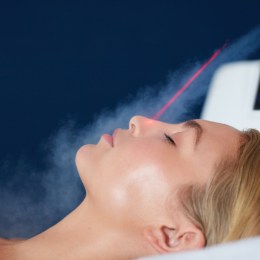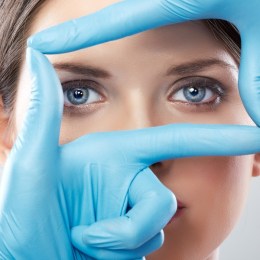In this world of over-sharing, there’s a strange cone of silence surrounding things that really matter and make a difference.
Among those “things” are subjects such as vaginal atrophy and dryness. Sooo not sexy, right?
Ironic, isn’t it, that the vagina is the epicentre of the giving of life, sex life and myriad salacious celebrity sex scandals.
But when it literally shrivels and dries up, the vagina becomes almost a taboo subject.
Some 80 percent of women post-menopause are “dried up”, according to Dr Louis Izzo, a Sydney professor of gynaeocology [not that Dr Izzo used that terminology, this editor hastens to add!].
“These include women aged from as young as their 20s,” he says. “It might be due to menopause triggered by chemotherapy for cancer; or natural menopause, which is occurring at earlier ages than ever before.
“This means that, for the next two thirds of their lives, these women will encounter difficulties having sex due to lack of lubrication. Their vaginas might be become so dry that sex becomes immensely uncomfortable or painful – even impossible.
“Imagine the pressure this puts on relationships and a woman’s own self-esteem and sense of sexual identity.
“Of course it is way more prevalent among women in their 40s-50s, the average age of menopause, when there’s still a good third of their lives to live.”
Women may also develop urinary stress incontinence; an embarrassing problem where urine leakage at the most inopportune times can have a major impact on their social life, on physical activities such as playing sport, running or cycling, going to the gym or doing yoga or Pilates, and even on the kinds of clothes they feel “safe” wearing.
Story short, around 2-3 months after a woman’s periods stop altogether, most women’s vaginal walls begin to atrophy, blocking secretions produced by the mucosa behind them, says Dr Izzo.
This results in a lack, or absence of lubrication during sex and can cause general inflammation, with burning and/or itching sensations, and leaving a woman more prone to vaginal infections.
So where is this scenario all leading? Until around three years ago, women suffering vaginal atrophy and/or dryness essentially had three options:
- Suffer in silence (which too many do, even today)
- Use OTC lubricants
- Take prescription oestrogen supplements, either orally or intra-vaginally.
Number 1 is hardly a satisfactory option, yet many women are too afraid or embarrassed to even talk about the issue, let alone seek help, says Dr Izzo.
Number 2 is merely a Band Aid measure, notably to make sex more comfortable, but isn’t very (or at all) effective when atrophy and dryness is severe.
Number 3 is not an option for many women, especially those who have suffered, or are at risk of developing oestrogen-sensitive cancers, such as of the breast and ovaries. Others also don’t like the systemic effects oestrogen supplementation can have, such as fluid retention, weight gain and breast swelling and tenderness.
Dr Izzo and fellow gynaecologists formed a lobby group to canvass for the latest in vaginal rejuvenation C02 lasers devices, FemTouch, to be brought to Australia.
Its manufacturer, the US device technology giant Lumenis – who brought us laser eye surgery and keyhole surgery – was won over by the passion of the Australian doctors for improving the quality of women’s lives.
Dr Izzo reports that 80-85 percent of women he and his colleagues have treated with FemTouch have reported significant improvements in the elasticity (thus tightness) of their vaginal walls and with lubrication.
WHAT IS VAGINAL LASER REJUVENATION TECHNOLOGY?
The treatment is based on the same principles as facial skin rejuvenation with CO2 fractional lasers.
“A laser probe is inserted into the vagina and rotates during a 5-15 minute treatment to ensure the entire area is covered,” says Dr Izzo.
“The laser makes little `dots’ in the lining of the vagina and the body’s natural healing response then stimulates the production of new collagen and elastin – studies using biopsies have shown this to be the case – which effectively rebuilds the skin of the vaginal wall and allows mucus secretions to once again flow through.
“I have not had one patient yet complain of pain, only a sensation of warmth.
“Patients are advised not to have sex for 24 hours after treatment, but otherwise can proceed with their lives and activities as normal.
“We recommend three treatments a month apart for optimum results, with patients reporting significant improvements as early as a month after the first treatment but generally after two treatments.
“These are women who in many cases have suffered atrophy and dryness for many years.”
WHAT DOES IT COST?
Dr Izzo says he and his fellow gynaecologists are offering this as strictly a medical treatment and, so, at affordable rates.
“I noted when on a visit to London that similar treatments are being offered to patients at the same kinds of fees as cosmetic rejuvenation treatments – at more than $2000 per treatment (taking into account our exchange rate),”he says.
“We are charging around $500 per treatment, and $300 for pensioners – after all, pensioners form a large part of the target audience for laser vaginal rejuvenation.”
WHY DON’T WE KNOW MORE ABOUT IT?
Laser vaginal rejuvenation technology has been available in Australia for nearly three years, with Deka’s Mona Lisa Touch, distributed by High Tech Laser, the first in the category to be embraced here, followed not long after by Lutronic’s Petit Lady II, distributed by Advanced Cosmeceuticals.
Women who have had the treatments wax lyrical about the results and the improvements to their relationships, self esteem and overall wellbeing as a result.
Yet when I tried to offer a story (for free) about the technology to a mainstream magazine I once worked for – I felt it was important for women to know about – I was obliquely told the subject matter “wasn’t suitable” for the audience.
Um, what? This, a magazine whose pay dirt is celebrity sex scandals, and its core demographic women 40+ – ie. the prime audience for this kind of technology!
And I never cease to be surprised by how many women still have never heard of the technology, no matter how up to date they keep themselves with what’s new and news.
American gynaecologist Dr Scott Eder is the principal investigator into the largest study worldwide into the use of this type of laser technology that is currently underway. He is visited Australia recently to share the findings of the trial (which has been underway for six months) so far.
“This new technology [FemTouch] is far superior to anything we’ve seen before,” De Eder says.
“It has five times deeper tissue penetration in a single pulse than any other system with no discomfort, meaning it has the ability to deliver a more effective treatment. It is also very fast, taking only a few minutes for the procedure, with three treatments four to six weeks apart. Women are able to return to normal activities the same day.
Dr Eder agreed that there is still a strange conspiracy of silence surrounding discussion of women’s intimate issues.
“For instance, in America in the 1970s, no one talked about breast cancer. That was until the-then First Lady Betty Ford was diagnosed with the disease and decided to go public for the benefit of other women.
“This started an avalanche of public conversation and sharing of information on the subject.
“In 2016, vaginal issues seem to be surrounded by the same kind of `taboo’ as breast cancer once was.
“But with the results we are achieving with this technology we hope word of mouth will soon break through this communication barrier, too.
“In the trials I am conducting I have been seeing success rates of 98-99 percent. One patient in her 50s reported she now had `the vagina of a 19-year-old’ and a number of husband have told me how much they appreciated the treatment, not just from the perspective of intercourse but how much happier and self-confident their wives were.
“Like men who experience sexual dysfunction, women deserve to be able to take steps to improve their sex lives.
“This procedure is significant not only for post-menopausal women, but women of all ages, particularly after childbirth. We strongly believe that this will help to improve the quality of life for many women, and the ability to embrace normal sexual intimacy again without the need for hormone treatment or more invasive management.”
For more information about vaginal laser rejuvenation procedures visit GYNAELASER.COM.AU




